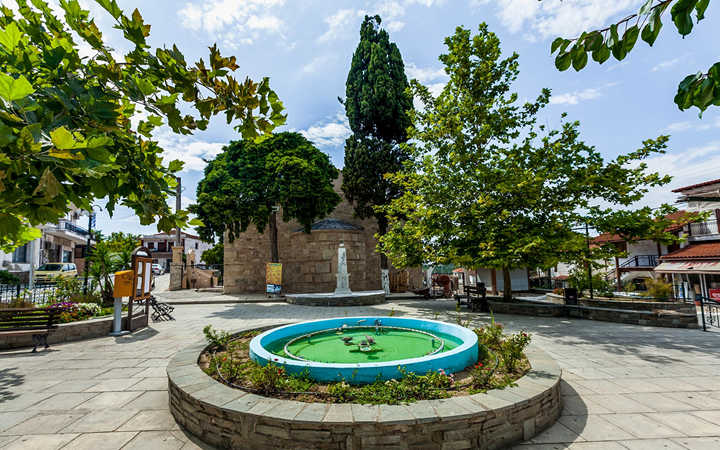Kalandra is about halfway down the west coast of Kassandra, just after the point where the peninsula takes an eastward bend. It's in the center of a smaller, southwestern-facing peninsula of its own which is a relatively flat plain, always rare in this country of hills, rocks, and mountains. After all, what is every one of Greece's 6,000 islands (only about 200 of which are inhabited), if not mostly submerged mountains?
The population of Kalandra, like that of most inland Greek villages, has declined over the years, from 641 in 1981, to about 500 today. It's a scenic little traditional village, with a lot of old stone houses, some of which have been beautifully restored. There are a number of places where you can rent rooms, usually much cheaper than you could if you were renting right on the beach. Kalandra, also like a lot of Greek villages that are not too far inland, has a seaside component, about 2.5 km away.
The seaside component is dominated by the large Mendi Hotel, which is really a resort, when you see how they've developed the beach, with palm trees, fountains, a large, curvy, palm tree-bordered swimming pool, tennis courts, and a generally park-like atmosphere.
The beach is clean, sandy, and not too crowded. There are sun beds and umbrellas spaced far enough apart to give you some privacy, and the water is an absolutely beautifully clear aquamarine.
Four kilometers up the beach to the west is Possidi, which is also considered a beach of Kalandra. Possidi has its own article on the Grekomania site.
Just next door to the resort is one of Halkidiki's most important archeological sites, Ancient Mendi. The site is about 1200m by 600m, on a hillside overlooking and flowing down to the sea.
Founded around 1100 BC, the name "Mendi" is derived from the ancient Greek root word for peppermint. Thucydides (460-400 BC) refers to Mendi as a colony of Eretria (Eretria being the small city-state on the island of Evia north of Athens that the Persians sacked when they invaded in 490 BC, just before the battle of Marathon.). Eretria founded a number of colonies in Halkidiki. In fact, Halkidiki takes its name from Halkida, a still-existing small city, and one-time city-state also on Evia and not far from Eretria.
Part of Mendi's attraction for the Eretrians were the gold and silver deposits found in the area, as witnessed by the many coins unearthed during the site's excavation. The colony saw growth during the 6th century, and had a great trade in locally vinted wine.
Mendi was one of Athens' strongest allies during the 5th century. It left the Athenian-led Delian League (created to repel future Persian aggression) during Athens' war with Sparta (Peloponnesian War 431-404 BC), which triggered an invasion by Athens. After Athens defeated and looted Mendi, Philip II of Macedon came in the middle of the 4th century, some 50 years later, leading to Mendi's reduced status as an important city.
The most famous personage from the ancient city was the sculptor Paigios, whose most famous work is a statue of Nike which was displayed in Olympia, in the Peloponnese. It's still there, in the Olympia Archeological Museum. The larger than life-size (2.16m) statue originally stood on a pedestal outside the entrance of the Olympia Zeus temple in Olympia. The statue's pedestal with inscriptions bearing the sculptor's signature was found in 1875.
Extensive excavations were carried out from 1986-1994 in Mendi. Many storage holes were found near the acropolis, which is called the Vigla. Inside the holes were ceramic vessels dating from the 12th-7th centuries BC. This pottery was decorated with geometric figures, typical for the region's pottery during that time period. Further digging in the "Proastia ("Suburb")" (which was referred to by Thucydides), near the coast, have uncovered parts of houses and streets dating from the 9th-4th century, BC). In the area of the Mendi hotel beach 241 graves, mostly of babies and children, were uncovered, dating from around the beginning of the 7th, to the end of the 6th centuries, BC.
At cape Possidi, 4km west of ancient Mendi, the sanctuary of the ancient city was found. As previously mentioned, Possidi is dealt at in length in another post, but suffice it to say that the complex of structures includes a 4th century Temple to Poseidon, and a number of other buildings dating from as early as the 12th century, BC.












